Local Middle School Girls Learn All About Materials at New Mid-GLAM Day Camp
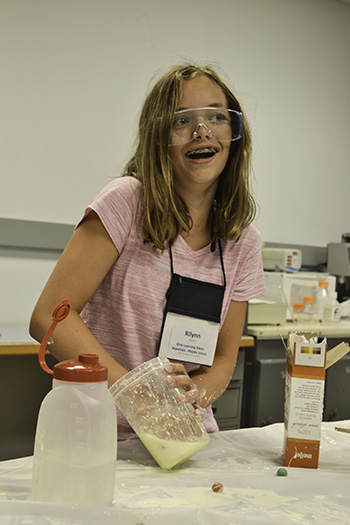
A Mid-GLAM camper mixes up some oobleck.
July 7, 2017
From playing with Oobleck, the non-Newtonian fluid made famous by Dr. Seuss (fun but quite messy), to making (and tasting!) chocolate ice cream frozen with liquid nitrogen, 20 local middle school girls not only had a good time at the first-ever Mid-GLAM camp held June 26–July 1. According to the camp’s co-directors, Materials Science and Engineering (MatSE) Assistant Professors Cecelia Leal and Robert Maass, the plan was that while the girls learned some things about materials science, their participation in the camp might also pique their interest in science, or even plant the seed that they too could be materials scientists.
Patterned after its older sister, GLAM (Girls Learn About Materials), a GAMES camp for high schoolers, Mid-GLAM not only similarly addressed materials engineering via engaging, hands-on activities, but borrowed part of its name from its older sibling. However, while GLAM is a residential camp for high school girls from around the state, Mid GLAM is a day camp for middle school students, and, for its maiden voyage, served only local students from the Campus Middle School for Girls.
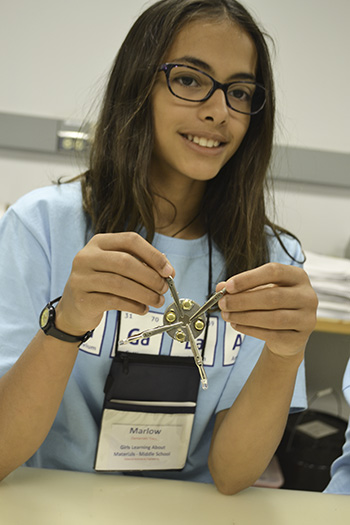
A Mid-GLAM camper shows the robot she and her teammates made.
Regarding the overall emphasis of their camp, Leal describes it in this way:
“There's a future out there, and as a material scientist, you want to know what that future will be made of. What will cars made of? What will medicines be made of? What will our clothes made of? What will our cell phones be made of? So as a material scientist, you are very interested in stuff, what it's made of, and how you can make it better.”
So that was the overarching theme of this summer’s camp—how to make stuff better. Specifically, the topics were: Making Stuff Stronger, Making Stuff Smarter…Smaller… Cleaner…and Tastier. Aactivities were related to what materials engineers do to make things better in the real world, which perfectly meshes with Maass's teacing philosophy.
“As an engineer, I think we should teach about what that means in our real world. So for me, it's always sort of this bridge between the discussion of something that you can basically hold in your hand and something that we can pull out from a book. This is probably one of the essences, or key factors, or cornerstones of my teaching philosophy.”
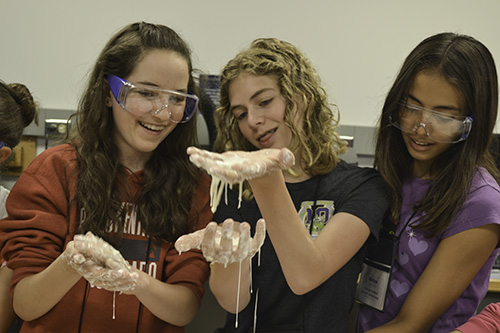
Mid-GLAM campers play with oobleck.
Maass emphasizes that their teaching style for the middle-schoolers was "Not a lecture! Because a lecture at that age is not going to fly. I mean that's just going to be super boring; basically they need to be involved.” Thus, Maass and Leal used interactive demos.
Each day’s agenda also included videos and hands-on activities about the main subject they were addressing that day. Then, each afternoon, the girls did a design challenge, where they were encouraged to "do hands-on—do something on their own.” These also involved making stuff better, as they were challenged to make things stronger…safer… faster…colder…and wilder!
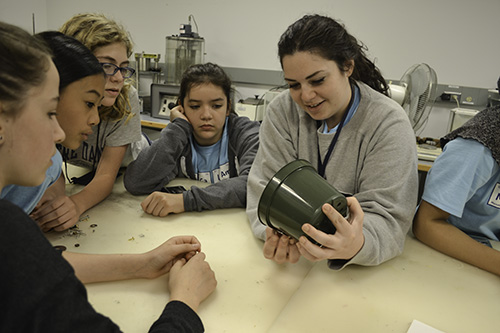
A MatSE grad student (right) shows campers how the robot they created can move with the help of a magnet.
To accomplish all of the different activities, Leal and Maass recruited some helpers: a grad student from each of their labs, plus a couple of summer undergrads from the department. And while the team designed some activities themselves, or expanded on things they’d been exposed to before, some were designed by the Materials Research Society and the National Science Foundation. Maass also reports that they left nothing to chance. They did trial runs of all the activities— testing them out in the lab to make sure they would work and to determine how much time they would take…all except the liquid nitrogen ice cream. They gambled on that activity…but got it down cold (this reporter got a spoonful!).
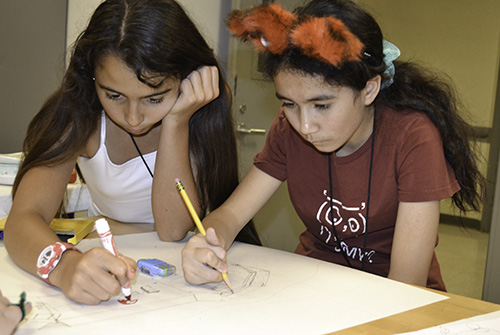
Campers work on their poster for the end-of-the-week poster session.
On Saturday, at an end-of-the-camp poster session, teams of girls presented the posters they’d created to show parents a bit about what they’d learned that week.
Why did Leal and Maass decide to create a new day camp for middle school girls? While they needed to do some sort of activity to fulfill the required outreach component for the National Science Foundation Career grants both received this past year, both were intrigued by the idea of doing an outreach to a younger age group—middle school students—in hopes of possibly impacting their career trajectories toward science—and possibly materials science, of course.
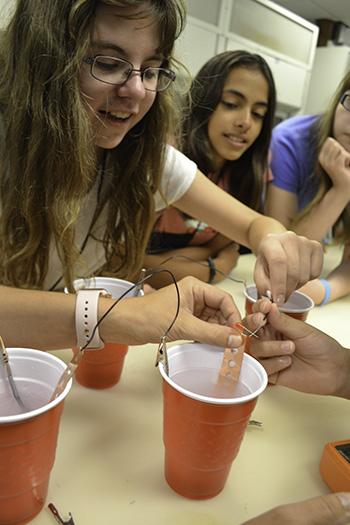
A Mid-GLAM makes an LED light light up by immersing copper in salt water.
While Maass’ general goal was to “reach out to the public and to help to promote fundamental science out there among the non-scientific community,” he also wanted to reach out to youngsters at a more impressionable age.
“So I wanted to target groups where I felt that it could be useful—where it can affect younger people's lives towards a certain direction.”
In fact, Maass believes it’s never too early to start exposing kids to STEM. “I like the idea of going down on the age bracket. I think it is easier to influence directions in young people when they are a little bit younger—they can't be too young, I believe—so middle school, absolutely.”
Leal agrees about impacting girls at a young age: “I'm very passionate about that. I think females, you need to encourage from early on. ‘It's possible; we can do this; we can be scientists…we can do anything.”
Also, both had the idea of doing something new, but not reinventing the wheel. For instance, Maass didn’t want to “start something new that is not embedded in the machinery of the university somehow, because then you do it and then it's dead, finished, because you're going to move on…That's a lot of energy that will be lost.”
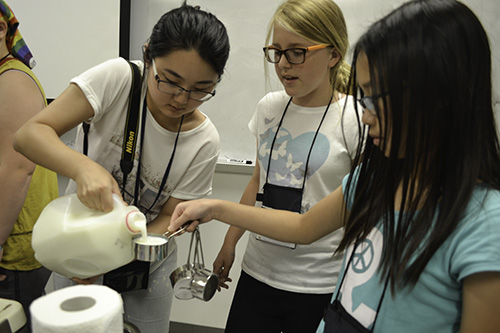
A grad student and some of her team of campers measure the milk for their ice cream.
Similarly, Leal hoped to take advantage of already-existing campus programs. “I didn't want to start anything completely new, so I went to an information session organized by the College on the sort of outreach activities our campus is running and how I could tag along in some of those.”
When she heard about GAMES, she thought: “This is a perfect opportunity where I'm not starting something new. GAMES is already in place. There's a lot of infrastructure already for that, except now we are offering activities that are more suitable for 6–12 year olds.”
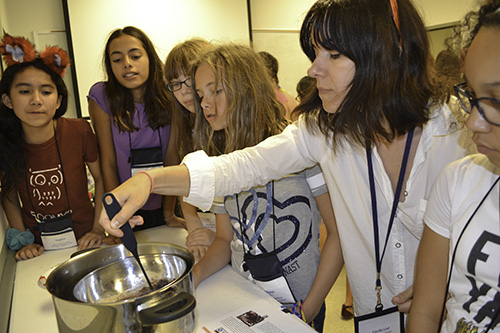
Leal stirs the ice cream concoction while the Mid-GLAM campers eagerly watch.
Leal’s vision for these middle schoolers is that they “develop an appreciation and a curiosity for what material science is and the problems that it addresses.” She goes on to explain that materials scientists address problems in making materials for medicine (her research), making better batteries, and making materials that can withstand extreme conditions like turbines on an airplane. “So this camp is devoted to that; it's to spark that curiosity and that interest for material science as a whole.” According to Leal, their plan was to “touch on these different classes of material—very simple, very hands on.”

A grad student adds liquid nitrogen while one of the campers stirs.
Should they include some activities about the materials they research? While Maass felt that Leal’s work with soft materials or bio-materials would be adaptable to activities, he wasn’t sure about the suitability of his. “I'm on the completely different end,” he explains. “I do metals. I was a little bit hesitant. How fun can it be for young kids, especially girls, to work with metals? How interesting is that to them?

Campers taste some of the liquid nitrogen ice cream they made.
In fact, he reports being “a little bit scared that it would be a complete disaster. I wasn't sure that would fly—a piece of steel!” So he decided to do a trial run. He contacted Leanne Cunningham, the Communications and Outreach Director at the Campus Middle School for Girls, begging her, "Let them come and visit.”
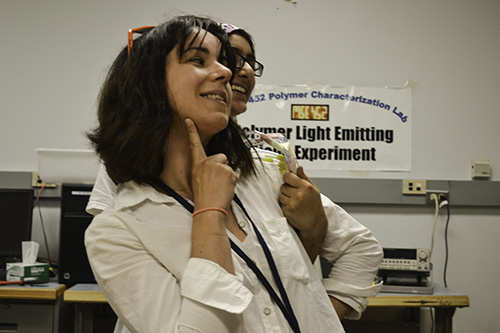
Leal and a camper horse around with the robotic hand they designed.
How’d the visit go? It went so well that the girls didn’t want to leave.
“They came and visited me, actually, a class, here, in my lab, and we had a whole bunch of little experiments, and they really liked it, so we had to cut it off. We all took too much time, because they asked so many questions, which encouraged me.”
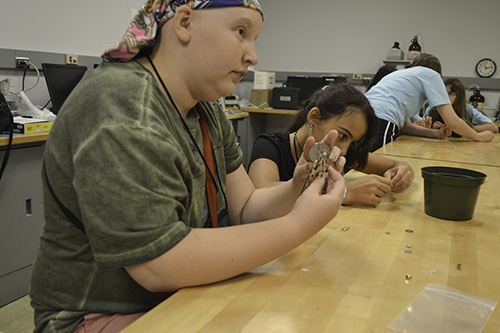
A Mid-GLAM camper works on building a robot.
And Maass liked the interaction so much that he agreed to do it for a whole week in the summer. “I was impressed by the intellectual capability of the girls [who] were here in my lab…That was fun, and this really motivated me to a part of this middle school range bracket,” he admits.
However, Maass calls distilling his metals research down to a level middle-school students can understand “a bit of a challenge.”
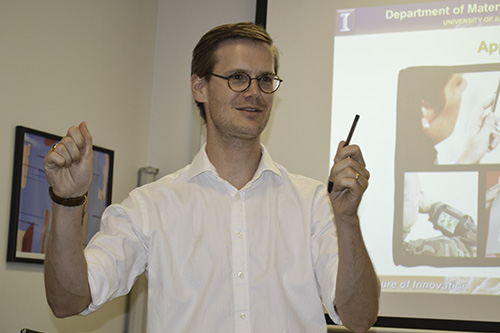
Maass discusses nanotechnology with the campers as part of the "Making Stuff Smaller" segment.
“Probably we're going to be less sophisticated than with the high school level…How much can you stretch in order to still convey a correct scientific picture, but without being too complicated. But again, the little test I had with this class here worked out fine, and I really liked that.”
Maass’s teaching style fit right in with the middle school students. He indicates that it involves getting feedback from his students, and reports that when he gives a lecture, “I always bring demo stuff. So something fun.”
He also seeks to foster dialogue with his students, something he employed with the middle schoolers. “I don't give lectures where I just ‘Blah, blah, blah.’ I do a lot of questions, back and forth.”
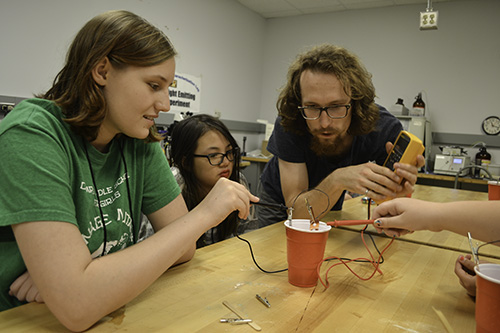
A MatSE Ph.D. student helping with the camp (right) watches as Mid-GLAM campers light up an LED light with the power produced by the battery the team made.
Although the first year is barely in the books, Leal is already making plans for the future: “We start just with one school as a pilot study in the first year, the first iteration of the camp, and then next year we are going to offer two more schools, but what we are going to do is that we are going to always make it local. We don't want to have overnight.”
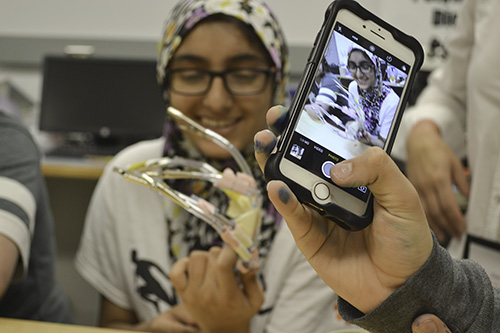
A student takes a photo of her friend and the robotic hand they created.
Story and photographs by Elizabeth Innes, Communications Specialist, I-STEM Education Initiative.
More: 6-8 Outreach, GAMES, GLAM, MatSE, Summer Camp, Women in STEM, 2017
For additional I-STEM articles on Materials Science and Engineering camps and outreach activities, see:
- Girls Learn About Materials Science at the 2016 GLAM G.A.M.E.S. Camp
- GLAM Seeks to Capture Girls' Imagination About Materials
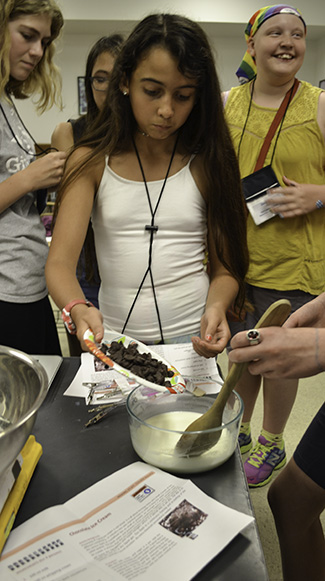
A Mid-GLAM camper adds chocolate to the ice cream mixture during the Making-Liquid-Nitrogen-Ice-Cream activity.
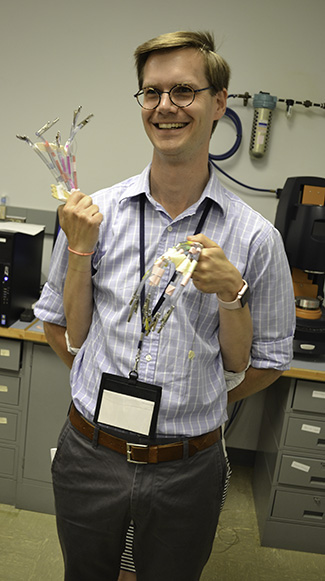
Leal and Maass kid around with the two robotic hands they created.
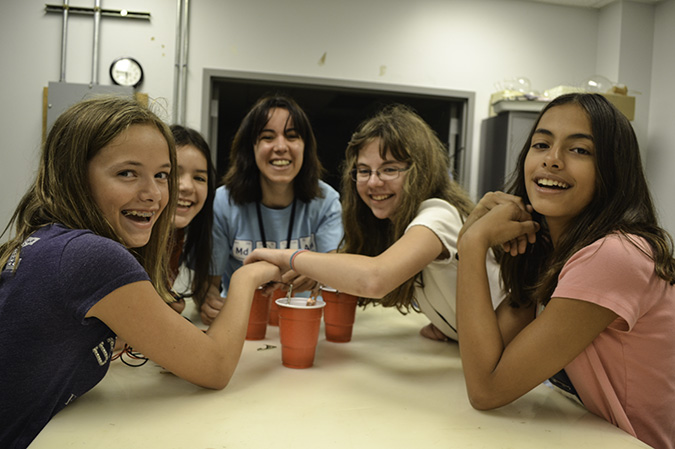
Leal (center) and a team of campers celebrate when their LED, powered by the eco-friendly battery they made, lights up.













.jpg)
















